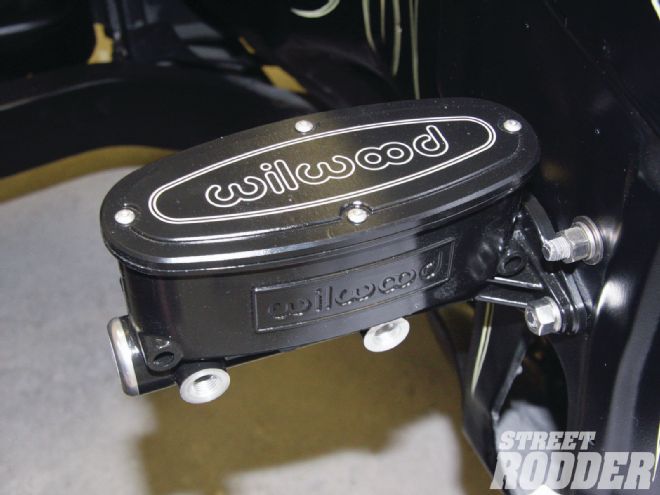
It’s probably a safe bet that street rodders tend to pay above-average attention to the maintenance of all their cars. But it’s probably an equally safe bet that few of us consider brake fluid as something that should be replaced on a regular basis, however let us explain why it should be.
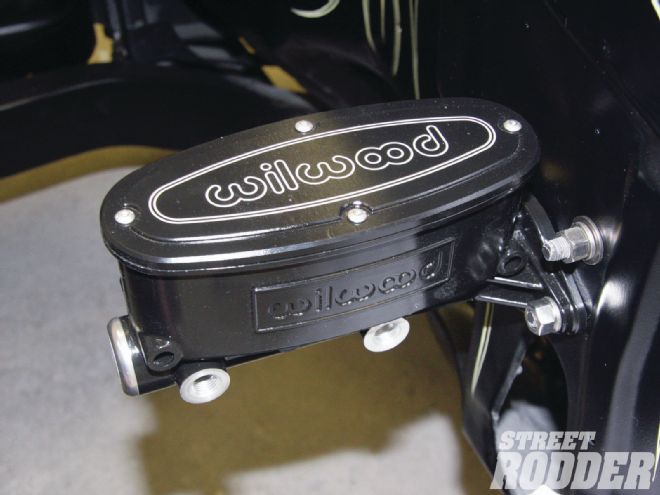 One of the areas of street rod construction that deserves special attention is the brake system. Using the proper components is a must, and so is maintaining them, which includes changing the fluid periodically.
One of the areas of street rod construction that deserves special attention is the brake system. Using the proper components is a must, and so is maintaining them, which includes changing the fluid periodically.
Brake fluid can easily become contaminated, and you don’t have to drive your car every day for it to happen. Moisture from the atmosphere can be absorbed by the brake system in a number of ways and it is a common problem. So much so that a recent National Highway Traffic Safety Administration (NHTSA) survey found that the brake fluid in 20 percent of 1,720 vehicles sampled contained 5 percent or more water.
Testing Brake Fluid
The condition of your car’s brake fluid is hard to determine visually, unless it’s extremely dark or has obvious signs of rust. However there are a number of affordable methods to check its condition:
An optical refractometer is a device that measures the amount of water in any water-soluble fluid. They’re used to examine everything from wine to maple syrup and there are versions for brake fluid as well as that will also test antifreeze levels. Prices range form as little as $60-$100 or more.
Many parts houses carry inexpensive chemical test strips that will show the presence of copper in brake fluid. When copper levels rise above the recommended level it’s an indication that the rust inhibitors in the fluid are no longer effective.
Electronic brake fluid testers measure the amount of water in the fluid. Surprisingly affordable, some sell for under $30. The test takes only about a minute and is quite accurate.
Brake Fluid Tips From AMSOIL Inc.
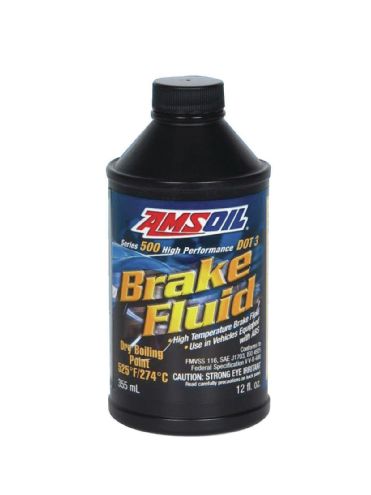 AMSOIL Inc. now offers Series 500 High-Performance DOT 3 Brake Fluid that will maintain a boiling point well beyond DOT standards even when contaminated with 3 percent water.
AMSOIL Inc. now offers Series 500 High-Performance DOT 3 Brake Fluid that will maintain a boiling point well beyond DOT standards even when contaminated with 3 percent water.
Brake Fluid Failure
There are two basic failure modes for brake fluid: It can boil, and it can cease to provide adequate lubrication and corrosion protection. Both are the result of contamination, usually with water or petroleum products.
DOT 3 and DOT 4 glycol brake fluids are hygroscopic; they absorb water easily and hold it in suspension, much like antifreeze. The second the cap is removed from a bottle of brake fluid, the brake fluid begins absorbing water from the air. And while brake fluid is kept in a closed system,
moisture seeps into the brake system continuously through the various seals and microscopic pores of the flexible brake lines. Moisture absorption through the brake system accelerates as vehicles age, and there’s almost no limit to how much water brake fluid can absorb. Water lowers the boiling point of brake fluid, which will eventually lead to failure. After two years of service, the average boiling point of brake fluid will have dropped below the minimum federal requirements.
High Boiling Points Prevent Failure
As the brake system heats up, brake fluids with low boiling points begin to vaporize. The brake pedal must travel further to apply the same amount of force on the brakes, causing a spongy feeling. If enough of the brake fluid is vaporized, brake system failure may occur.
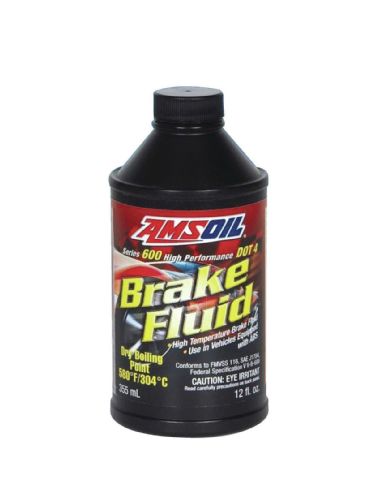 Series 600 High-Performance and Racing DOT 4 brake fluid from is designed for high-temperature stability and will remain virtually incompressible, even at the highest pressures generated in braking systems. Both Series 500 and 600 exceed Federal Motor Vehicle Safety Standard No. 116 and all requirements of the DOT.
Series 600 High-Performance and Racing DOT 4 brake fluid from is designed for high-temperature stability and will remain virtually incompressible, even at the highest pressures generated in braking systems. Both Series 500 and 600 exceed Federal Motor Vehicle Safety Standard No. 116 and all requirements of the DOT.
Brake fluid boiling points are measured on two separate scales: (1) dry equilibrium reflux boiling point (ERBP), the boiling point of new, freshly opened unused fluid; and (2) wet ERBP, the boiling point of a brake fluid after it has absorbed 3 percent water.
The Department of Transportation (DOT) has set minimum standard requirements to ensure brake fluids will provide adequate protection. The minimum dry ERBP for DOT 3 brake fluid is no less than 205 degrees C (401 degrees F), the minimum wet ERBP is 140 degrees C (284 degrees F). It only takes 4 percent water contamination to bring a DOT 3 fluid’s boiling point down to the federal limit.
The minimum dry ERBP for DOT 4 brake fluid is 230 degrees C (446 degrees F), the minimum wet ERBP is 155 degrees C (311 degrees F). Their higher boiling points make DOT 4 fluids appropriate for high-performance cars and motorcycles, and for vehicles used for towing. Because brake fluids are hygroscopic, the wet boiling point is of much greater concern than the dry boiling point.
AMSOIL Inc. Brake Fluids
AMSOIL Inc. brake fluids exceed government standards. The Series 500 DOT 3 High-Performance and Series 600 DOT 4 Racing brake fluids maintain a stable viscosity over a
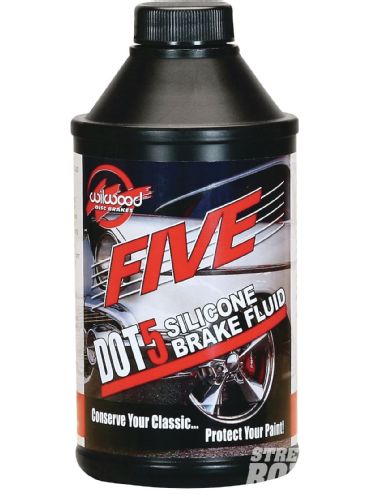 For those who worry about damage to paint from spilled brake fluid, Wilwood offers Dot 5 silicone brake fluid.
For those who worry about damage to paint from spilled brake fluid, Wilwood offers Dot 5 silicone brake fluid.
wide temperature range and provide lubrication throughout the system. Their additive packages can raise boiling points to more than 232 degrees C (450 degrees F.) They keep water in suspension, slowing its effects on the brake system.
Brake Fluid Basics from Wilwood
Due to the extreme operating temperatures of a high-performance brake system, standard off-the-shelf brake fluids are not recommended. Of critical importance in determining a fluid’s ability to handle high-temperature applications is the Dry Boiling Point and compressibility.
The Dry Boiling Point is the temperature at which a brake fluid will boil in its virgin non-contaminated state. The highest temperature Dry Boiling Point available in a DOT 3 fluid is 572 degrees F.
The Wet Boiling Point is the temperature a brake fluid will boil after it has been fully saturated with moisture. The DOT 3 requirement for wet boiling point is a minimum temperature of 284 degrees F.
DOT 3, DOT 4, and DOT 5.1 glycol-based brake fluids are hygroscopic, meaning that they absorb moisture. There are many ways for moisture to enter your brake system. Condensation from regular use, washing the vehicle, and humidity are the most common, with little hope of prevention. However, contrary to popular belief, water that has been absorbed into glycol-based fluids will not in itself cause corrosion or oxidation the way that free-floating water and vapor could in a system that is filled with DOT 5 silicone fluid.
Silicone fluid does not absorb moisture. As a result free water vapor within the system will be more corrosive and likely to cause oxidation of any ferrous components. In addition, the water will vaporize and boil at a much lower temperature and contribute to brake fade at water’s boiling point, rather than the higher boiling of glycol-based fluids that have absorbed that moisture. Knowing in advance that most drivers will not maintain a regular fluid maintenance interval, auto manufacturers specify glycol-based fluids for that reason.
Many racers were initially attracted to silicone fluids because of the high-rated boiling points compared to most standard DOT 3 or 4 fluids. However, the chemical composition of silicone fluid causes it to be far more
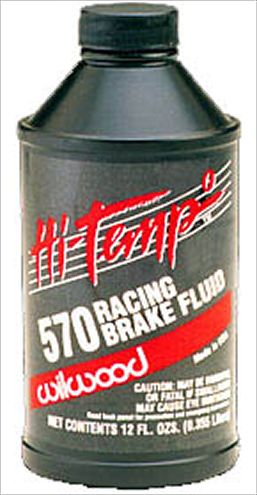 Wilwood’s specially formulated Hi-Temp 570 Racing Brake Fluid has a minimum 570 degrees F. Dry boiling point to withstand the severe heat requirements of automotive racing.
Wilwood’s specially formulated Hi-Temp 570 Racing Brake Fluid has a minimum 570 degrees F. Dry boiling point to withstand the severe heat requirements of automotive racing.
compressible and easily aerated as compared to glycol-based fluids. Aeration and high compressibility can give a spongy brake pedal feel that never goes away, and can also reach a pedal fade point far sooner in competition than glycol-based fluids, therefore glycol-based fluids are always preferred for competition. Also, DOT 5 silicone fluids are not compatible with ABS systems. DOT 3, 4, and 5.1 fluids contain lubrication additives that are necessary to keep ABS internal components functioning properly.
Since silicone fluids do not absorb moisture, systems using silicone must be flushed and maintained at more frequent intervals than glycol-based fluids. The typical life expectancy of glycol-based fluids is about two years. As the moisture content of glycol-based fluids increases with time and exposure to atmosphere, the color changes from light clear or amber to a darker brown color. Local climate will impact the life cycle of fluid, based on average humidity.
The primary advantage to using silicone fluid is that it is paint friendly. Some motorcycle manufacturers also specify silicone fluid because of the effects that glycol-based fluids can have on some plastics.
Owners of show cars that use silicone fluid to prevent paint damage in the case of a spill or leak must also flush their system at periodic intervals to make sure that any moisture that may have entered the system be evacuated to prevent localized corrosion and the possibility of vaporization under heat that would cause pedal fade.
DOT 3, 4, and 5.1 glycol-based fluids are fully compatible with each other, however they will not mix with DOT 5 silicone. When mixed together, silicone fluid and glycol fluids will form a gel-like sludge in the brake system. Anyone considering changing from one fluid type to another must take all necessary measures to be sure the old fluid has been completely eliminated from the system.
Keep in mind, glycol-based fluids cannot only damage paint, they are also toxic. Any brake bleeding operation should include a small-diameter hose attached to the bleeder on one end and a collection container on the other. All of the purged fluid should be captured and properly disposed of, just like you would with used engine oil.
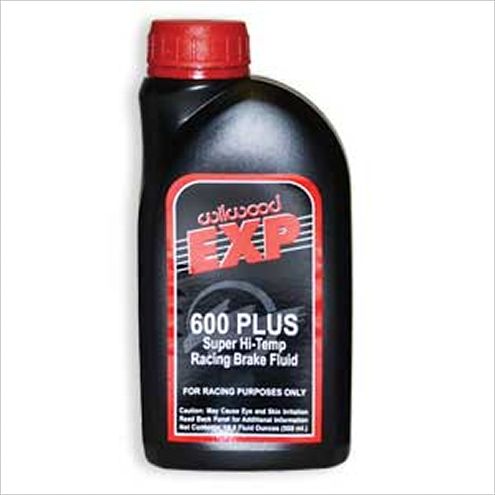 EXP 600 Plus from Wilwood is a highly refined blend developed for extreme performance under the high heat and extreme pressure of professional motorsports. It has been tested to 626 degrees F with a wet boiling point of 417 degrees F. These numbers far exceed any DOT or SAE specifications.
EXP 600 Plus from Wilwood is a highly refined blend developed for extreme performance under the high heat and extreme pressure of professional motorsports. It has been tested to 626 degrees F with a wet boiling point of 417 degrees F. These numbers far exceed any DOT or SAE specifications.
It should be pointed out that not all DOT 3, DOT 4, and DOT 5.1 compliant are the same. Although they will share the same minimum wet boiling point required by DOT, they can be formulated to begin life at a much higher dry boiling point. Dry boiling point pertains to new fluid that has not yet been able to absorb water vapor out of the atmosphere. Wet boiling occurs when fluid has reached maximum water saturation after. Performance grade and racing grade fluids such as Wilwood’s DOT 3–compliant Hi-Temp 570 and DOT 4–compliant EXP 600 Plus Super Hi-Temp fluids are formulated to have much higher boiling points.
Racers who maintain regular bleeding and maintenance cycles on their fluids have the best opportunity to prevent heat-induced brake pedal fade by keeping the fluid in the system fresh and at the highest possible boiling point. Fluid that has deteriorated to its wet boiling point will boil and
fade far sooner in the heat of competition.
For high-performance applications, fluids such as Wilwood’s EXP 600 Plus have a higher specific gravity and lower viscosity than standard DOT 3 or 4 compatible fluids. Race fortified fluids will be far less compressible in high-heat conditions, and maintain a firmer, more consistent feel in sustained high-heat conditions.
When adding fresh fluid to a brake system never mix fluids of DOT classifications as it will cause contamination and lower the boiling point. For maximum performance, start with the highest Dry Boiling Point available, flush the system completely, and flush it regularly, especially after severe temperatures have been experienced.
Advice on Bleeding Brakes from Wilwood
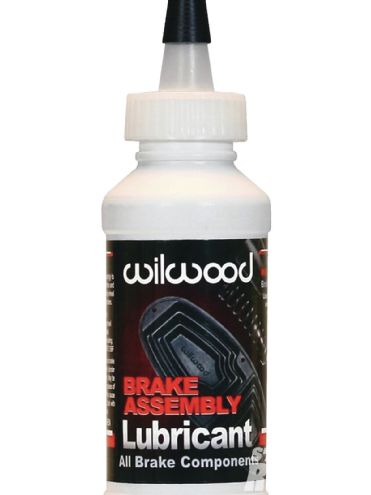 Wilwood’s synthetic assembly lubricant is designed to be used on pistons and rubber seals when overhauling brake system components.
Wilwood’s synthetic assembly lubricant is designed to be used on pistons and rubber seals when overhauling brake system components.
When replacing a master cylinder, always bench bleed it first and then the system.
Before beginning to bleed the system, make sure all calipers have bleed screws facing upward to fully evacuate air from the system. Wilwood calipers with internal fluid passages and four bleed screws (two on each end) require only the upward facing bleed screws to be bled. Start bleeding the bleed screw farthest from the master cylinder (typically the right rear caliper outboard half), and work toward the one nearest the master cylinder.
The most common method to bleed a system is to manually pump the pedal. This process is as follows: Pedal bleeding requires two people; one person pumps the pedal, and the other operates the bleed valves. First, connect a plastic hose to the valve on the outboard body bleed screw farthest away from the master cylinder. Submerge the other end of the hose in a container of brake fluid to ensure that no air is siphoned back into the system. Have the person in the vehicle depress the pedal and hold it at the floor. With the pedal on the floor, the person at the caliper should open the bleed screw a quarter of a turn to allow the accumulated air and fluid to evacuate. Once the air and fluid have
stopped flowing out of the bleeder valve, close it. Now, the person in the vehicle should slowly pump the pedal to refill the calipers with fluid.
Once a firm pedal has been achieved, the pedal operator should depress the pedal and hold it, repeating the above sequence. Make sure that the reservoir of the master cylinder does not run out of fluid, as this will introduce air into the system. Continue in this manner until all calipers are bled on both the inboard and outboard bleed screw. You may have to repeat the process for optimal results. Three other methods to bleed a system are gravity, pressure, and vacuum.
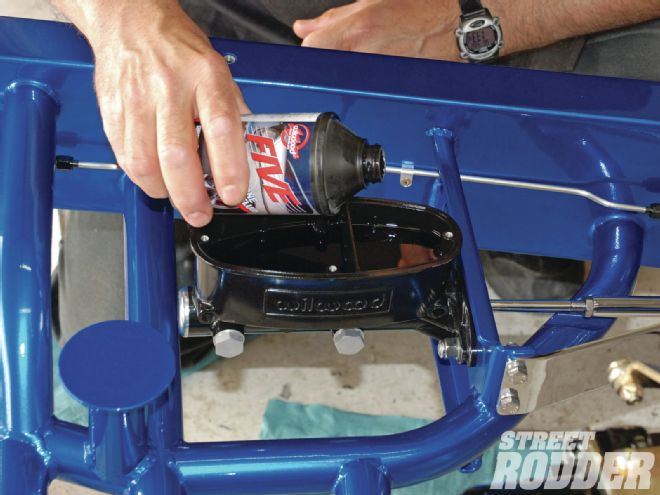 When topping off a brake system, always use fluid from a well-sealed container to prevent introducing moisture to the system.
When topping off a brake system, always use fluid from a well-sealed container to prevent introducing moisture to the system.
Gravity bleeding can be done when the master cylinder is higher than the wheel cylinders. It’s simply a matter of cracking the bleeders open and letting fluid drain until all the air is removed. It’s effective but a very slow process.
Pressure bleeding is done with a device that forces fluid into the reservoir and as a result air is pushed through the system and released at the bleeders as with standard procedures.
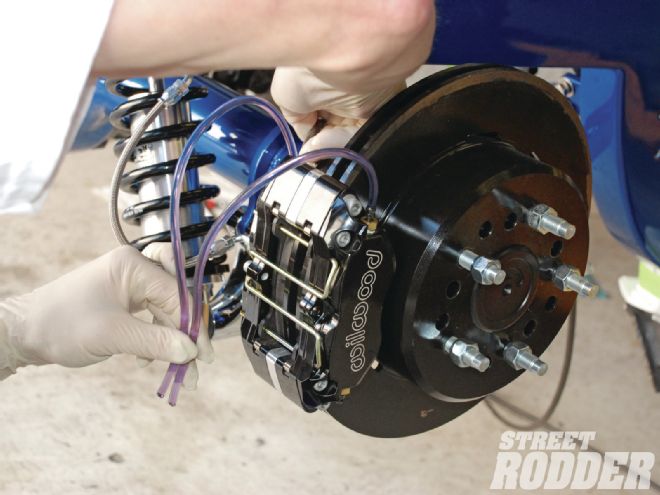 Brake bleeders should be located at the highest point in the caliper or wheel cylinders. Fluid should be pumped through the system until all air is removed, and don’t forget to catch any lost fluid in a container.
Brake bleeders should be located at the highest point in the caliper or wheel cylinders. Fluid should be pumped through the system until all air is removed, and don’t forget to catch any lost fluid in a container.
Vacuum bleeding is done with a pump attached to the bleeders. Fluid is drawn into a container through a clear plastic hose. When no bubbles are seen in the fluid the system is bled.
When Should You Change Your Brake Fluid?
As we’ve pointed out brake fluid will absorb moisture from the air, so use is less of a factor than you might think. Interestingly, most domestic automobile manufacturers don’t provide recommended intervals for changing brake fluid, however most European and Japanese companies recommend changing fluid anywhere from 24-36 months.
Considering the fact that as little as 1 percent water can reduce the boiling point of brake fluid any contamination is cause for concern. Given the minor investment involved, and the possible benefits in an emergency situation, changing brake fluid regularly should be part of your street rod’s maintenance program.